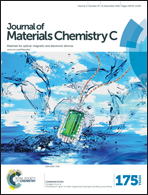Magnetic transitions and isotropic versus anisotropic magnetic behaviour of [CH3NH3][M(HCOO)3] M = Mn2+, Co2+, Ni2+, Cu2+ metal–organic perovskites†
Abstract
Here we present an in-depth study of the magnetic properties of a family of metal–organic perovskites ABX3, [CH3NH3][M(HCOO)3] in which A = CH3NH3+ is the methylammonium cation, B = M is a divalent metal cation (Mn2+, Co2+, Ni2+ or Cu2+), and X is the formate anion (HCOO−). The magnetic properties have been measured on powdered samples and along the different orientations of mm-sized single crystals. They display spin-canted weak ferromagnetism with Néel temperatures of 8.0 K (Mn2+), 15.7 K (Co2+) and 34 K (Ni2+), which are inversely proportional to the ionic radii of the metal cations. The Cu2+ member displays low-dimensional magnetism as a result of orbital ordering of the Cu2+ d orbitals originating from a Jahn–Teller distortion. Pulsed-field magnetization experiments (fields of up to 60 T at temperatures down to 0.6 K) show that Mn2+, Co2+ and Ni2+ formates display cation-characteristic spin flop transitions. A saturation magnetization value of 5 μB (at 12.5 T) was observed for Mn2+, meanwhile the Co2+ formate shows an orientation dependent quasi saturation (5.1 μB at 21 T along [101] vs. 5.8 μB at 26 T along [010]). The different isotropic/anisotropic behaviour can be explained by the orbital contribution to the magnetic response.
![Graphical abstract: Magnetic transitions and isotropic versus anisotropic magnetic behaviour of [CH3NH3][M(HCOO)3] M = Mn2+, Co2+, Ni2+, Cu2+ metal–organic perovskites](/en/Image/Get?imageInfo.ImageType=GA&imageInfo.ImageIdentifier.ManuscriptID=C6TC03992H&imageInfo.ImageIdentifier.Year=2016)


 Please wait while we load your content...
Please wait while we load your content...